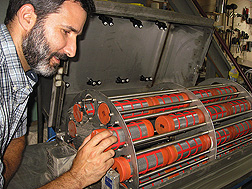Lab Saves Water While Researching New Ways To Fight Weeds
Some weed species have a nifty survival strategy. In a given field, less than half of their total store of seeds will germinate, while the other portion remains dormant in soil. These so-called seed banks are waiting to sprout another day—long after the effects of herbicides have worn off, for example.
“Reducing seed banks of annual weeds such as common lambsquarters, giant foxtail, and common waterhemp is among the most important steps that farmers can take in managing weed populations in crop fields,” says ARS ecologist Adam S. Davis. “But how to do that in a sustainable manner isn’t known.”
One possibility being explored by Davis and others in ARS’s Invasive Weed Management Research Unit at Urbana, Illinois, is to encourage predation of weed seeds by birds, rodents, insects, and even bacteria. (See “Unearthing New Clues to Controlling Weeds,” Agricultural Research, May 2006.)
But matching the right predator to its host weed requires considerable field data. Fortunately, the scientists can rely on a device known as an “elutriator.” About the size of a gas grill, it fires high-powered jets of water into soil-core samples containing weed seeds taken 10 to 30 centimeters below the surface of crop fields. Scientists then collect the seeds to determine their species, number, health, and ability to germinate.
Up until a few years ago, says Davis, this seed sorting was done by hand over a sink with the faucet running. Now, that tedious and time-consuming process is carried out with high efficiency by the elutriator, which can handle 48 soil-core tubes. It blasts them with water at the rate of nearly 6 gallons a minute, or 360 gallons an hour, to extract the seeds inside. ARS plant physiologist Lori Wiles, in 1996, designed the current model Davis’s lab uses.
“The elutriator is really important to our research. It gives us the capability to do seed-bank studies that few other laboratories have,” says Davis. “But we were feeling guilty about using all that water.”
Enter James L. Moody, the lab’s biological science technician. After listening to the scientists’ concerns, Moody took a closer look at the machine and saw room for improvement. By making a few modifications, including hooking up a submersible pump to the elutriator’s settling tank and installing a water meter and a flow-limiting valve in the water line, Moody successfully put those worries to rest.
Indeed, in later trial runs and research, his modified elutriator consistently reduced the machine’s water use by nearly 13 percent, or 50 gallons per hour, mainly by recycling the water. More tweaking is planned. In fact, says Davis, “We’re aiming for a 50-percent reduction.”—By Jan Suszkiw, Agricultural Research Service Information Staff.
This research is part of Plant Biological and Molecular Processes (#302) and Crop Protection and Quarantine (#304), two ARS national programs described on the World Wide Web at www.nps.ars.usda.gov.
Adam S. Davis is in the USDA-ARS Invasive Weed Management Research Unit, 1102 S. Goodwin Ave., Urbana, IL 61801; phone (217) 333-9654, fax (217) 333-5251.
"Lab Saves Water While Researching New Ways To Fight Weeds" was published in the February 2009 issue of Agricultural Research magazine.







